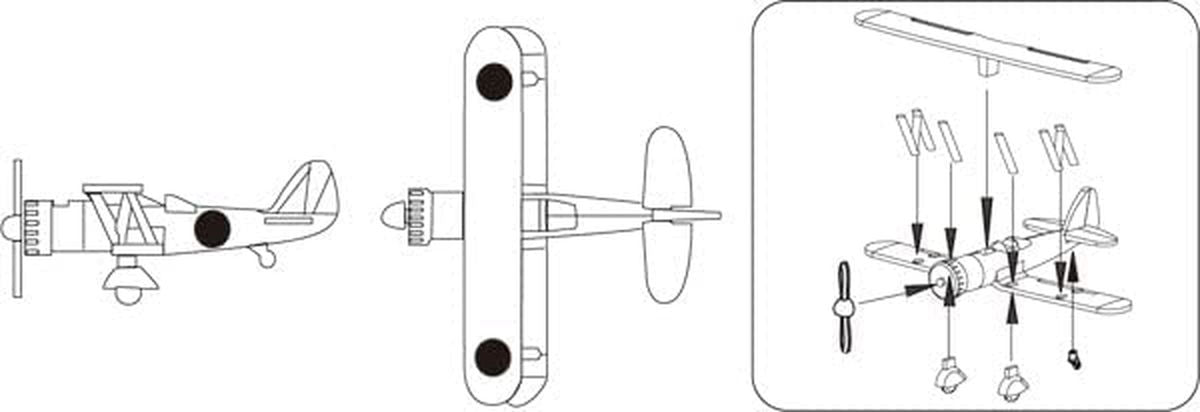――Before the Pacific War, a set of carrier-based aircraft from the Sino-Japanese War to the mid-1945s!
--The product is an unpainted kit that requires adhesive assembly and painting on a 1/700 scale.
--This product uses a conventional (G-up series) mold.
――Before the start of the war from Taisho to Showa, which was the transition period from biplanes to monoplanes after the era of trial and error from the appearance of aircraft and aircraft carriers.
--The number of aircraft carriers is steadily increasing, such as Fengxiang, Akagi, Kaga, and Ryujo, and the carrier-based aircraft has evolved into a 96-type shipboard fighter that serves as a bridge to the 9-type, 95-type, and zero battles.
--The Type 99 and Type 96 warships are the predecessors of the Type 99 and Type 99 warships, respectively, and even after the start of the war, some models will continue to be carried on the small aircraft carriers Shoho and Hosho. Was there.
--It is designed as an aircraft carrier-based aircraft that matches the [precision] concept of the special series.
-All-in-one set of carrier-capable fighter, bomber, and attack aircraft to make it convenient to have pre-war carrier-based aircraft.
-Ideal for use in the shape of Kaga / Akagi in the three-deck era and the shape of Fengxiang / Ryujo one generation ago.
[Content]
――The number of models and number of aircraft is 9 for carrier-capable fighter aircraft.
-Includes 6 types of 96-type carrier-based bombers and 6-type 96-type carrier-capable attack aircraft, including 28 fighter aircraft.
――The molding color is gray, which reduces the risk of damage during work compared to the conventional transparent.
-A decal is attached for nationality marking.
[Compatible aircraft carrier]
--Aircraft carrier [Akagi] [Kaga] [Fengxiang] [Ryujo] [Soryu] [Hiryu] and [Shoho] [Zuiho] [Kasugamaru], adapted as a carrier-based aircraft for the prewar and postwar wars.
[Nakajima A2N fighter]
--This is the first domestic (Nakajima) carrier-capable fighter adopted in 1952, and is installed in Akagi / Kaga and Hosho / Ryujo.
--Kaga, Ryujo, and Fengxiang aircraft are participating in the Sino-Japanese War.
――The number of parts is 4 per aircraft (aircraft, propeller, upper wing, main landing gear).
――Although the wing struts are omitted, the parts are easy to make.
――The two-winged propeller is a separate part from the fuselage, increasing the sense of precision.
—— 4 machines included.
[Nakajima A4N fighter]
--Adopted in 1945, it is the last carrier-capable fighter as a biplane, and is installed in Soryu, Fengxiang, and Ryujo.
――The number of parts is 10 per aircraft (aircraft, upper wing, wing strut, propeller, main landing gear, tail wheel).
――By dividing the parts, the wing struts unique to the biplane are made into parts, and the shape is accurately reproduced.
――The propeller is a separate part of the windshield, so it is easy to paint separately and it can be reproduced three-dimensionally.
-Includes 6 machines.
[Type 96 shipboard fighter]
--The first all-gold monoplane fighter, a masterpiece adopted in 1945.
――The motif of the product is the No. 4 type, which is a 3-wing propeller equipped with a motor [Shou].
--Fengxiang, Akagi, Kaga, Soryu, Hiryu, and at the beginning of the war, it is installed in Ryujo, Shoho, Zuiho, and Kasugamaru.
――The number of parts is 5 per machine (aircraft, propeller, main landing gear, drop tank).
-The panel line on the wing surface is delicately engraved, and the unique shape of the nose engine is reproduced on a 1/700 scale.
-Includes 6 machines.
[Type 96 carrier bomber]
--Adopted in 1945 as the main aircraft until the Type 99 rifle appeared, and used on land as a training vessel bomb until the end of the war.
--Installed on Akagi / Kaga, which became the entire deck before the war, and Soryu / Hiryu, which was completed.
――The number of parts is 6 per aircraft (aircraft, upper wing, wing strut, main landing gear, tail wheel).
――By dividing the parts, the wing struts unique to the biplane are made into parts, and the shape is accurately reproduced.
-Includes 6 machines.
[Type 96 carrier-capable attack aircraft]
--The aircraft was developed by the Aircraft Factory and was adopted in 1945. The last biplane carrier-capable attack aircraft.
--Onboard Akagi, Kaga, and Soryu, and Fengxiang will be installed until the middle of the war.
――The number of parts is 10 per aircraft (aircraft, upper wing, wing strut, propeller, main landing gear, tail wheel).
-The wing strut is a separate part, and it is a specification that increases the sense of precision after assembly.
-The flaps are engraved on the wings, and the convex bulge is also expressed on the motor cowling.
-Includes 6 machines.
[Attached decal]
――The upper and lower surfaces of the main wing and the Hinomaru mark on the fuselage (without / with white border) are recorded.
――There are multiple sizes of the Hinomaru, and it is convenient to divert because it contains more than the required number.
※The image is an image. It may differ from the actual product.













